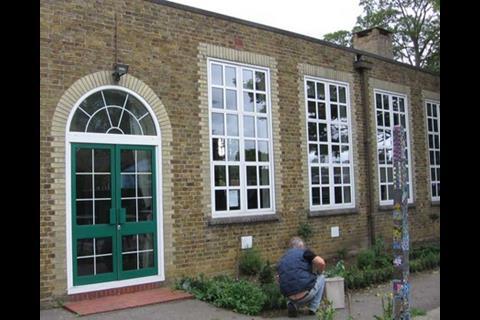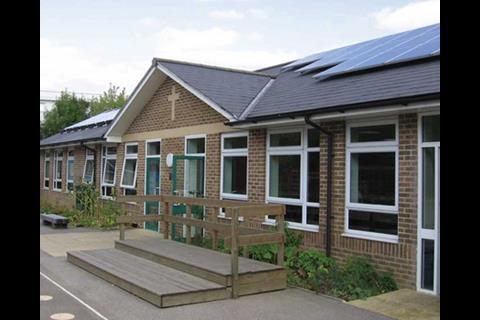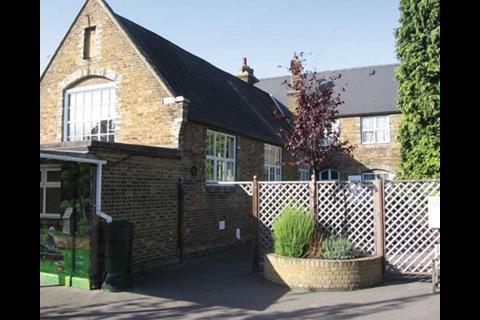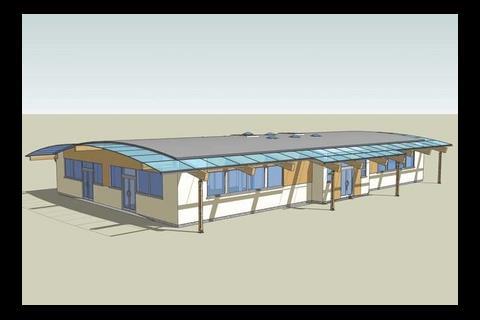Ashley Primary School is run with such zeal for the environment that when an expansion became necessary, it grabbed the chance to increase its sustainability credentials
‘The little green school with the big green attitude.” These are the words emblazoned across the jute bags carried by many parents as they arrive to collect their children from Ashley Church of England Primary School in Walton-on-Thames. It’s a catchy slogan, but also an important mantra of headteacher Richard Dunne, who wants the school to educate and operate as sustainably as possible.
Like countless other schools in the UK, Ashley began life as a single-storey Victorian building, only to be turned into a warren of poster-adorned corridors and high-ceilinged classrooms by generations of additions and extensions. It’s a vibrant place full of happy kids, but it isn’t exactly environment-friendly.
And yet, Dunne, his staff and the kids are championing sustainability. Lessons are geared towards it, and posters throughout the building remind everyone to turn off lights and computers. Lighting is energy efficient throughout; a biomass boiler provides heat; 50 solar photovoltaic panels generate electricity and eight solar thermal panels warm the water for a small swimming pool and the hot water system.
The fruits of this fervent energy-saving drive are displayed in the EcoZone on the school’s website, and incentives are given to encourage the kids to go further.
Dunne’s enthusiasm has transformed the school into one parents are happy to send their children to. Ashley’s present roll call of 300 is to be expanded in the next four years to 420. To accommodate this rise, the school will require modernisation and substantial additions, including a full “community” kitchen, a bigger hall, four receptions and year one classrooms and two classrooms for years five and six.
“It is an exciting prospect,” says Dunne, “one that we’re tackling in the same way that we run the school, with environmental best practice. Our challenge is to get the most out of the budget without compromising on our core sustainable values. I’d hate to see, like on so many other well-meaning projects, the green elements slowly dropping by the wayside as the project progresses and the costs escalate.”
Designing this mini green exemplar is Fairhursts Design Group (FDG). The architect, and engineer Gifford, have developed a masterplan for the site, and buildings that first and foremost encompass passive sustainable design. The structural glulam frames are clad in Forest Stewardship Council-rated timber or hemcrete. A high level of insulation reduces energy loss, while glazing, rooflights and sun pipes (with integrated ventilation run by photovoltaic panels) maximise natural light in all areas, especially classrooms.
“The envelope is super efficient,” says FDG architect Eddy Fell. “It is part of a strategy that concentrates on getting the basics right, before looking to include advanced technologies. We are even reusing salvageable doors and windows from the existing building where possible, to save on waste and money.”
Dunne agrees wholeheartedly with this thrifty philosophy. “Natural light is so much nicer for the children to work in, and it reduces our energy outgoings considerably,” he says. “The same goes for insulating the building well and promoting natural ventilation, rather than mechanical; it’s all more healthy and less costly.”
When considering how best to produce heat and power for the school, the design team has forgone photovoltaics or wind turbines for the time being. Air and ground-source heat pumps are to be installed, as is a hybrid boiler that can burn various fuels and be connected to renewable or conventional energy sources if required in the future. “It’s renewable-enabled, so we can plug them in when they become financially viable for the school,” says Fell.
Throughout the design process, the school, its governors and local planners have been heavily involved. FDG has held regular workshops to set out its designs and address any misgivings. “This consultation could have been done quicker,” says Fell, “but by including everyone – kids too – we have developed a scheme that satisfies the planners and has the backing of all concerned.”
Dunne adds: “The children can see the things they’re taught being built into their new school. It draws out even more enthusiasm and encourages them to ask key questions, not just about building a green school but how we can improve the sustainability of the life we lead.”
The design team is currently working on a finishes schedule. It has engaged the kids, getting feedback on areas such as play spaces and is now assessing material choices for their green potential against a host of criteria including durability, recyclability or reusability, local availability and the minimisation of waste (materials and packaging).
Work is due to start in the summer of 2010 on the kitchen and hall and one of the classrooms blocks. Hoardings around the building sites will have windows in them for the kids to check in on their new school – so they can “keep tabs on the environmental design,” says Dunne.
The project managers are about to start their search for the perfect construction partner to help transform the vision into reality. FDG’s design for the school is based on a 60-year lifecycle. This isn’t make-do and mend, but nor is it a groundbreaking project that will be riddled with glitches and problems owing to untried materials or techniques. As things stand, the design is on course to achieve BREEAM “excellent”, a step above the environmental target of “very good” that was set at the start of the project. However, the enthusiasm of the kids has rubbed off on the design team and now Fell believes the school could reach BREEAM “outstanding” if it goes ahead with installing renewable energies in the near future.
“This is more than a building project for Ashley Primary School,” says Dunne. “It is a vision that joins up the thinking of the school. It reaffirms our core messages of values-based learning that nurtures the whole child, mentally, physically and spiritually; integration with local and global community; and engendering a sense of responsibility both socially and sustainably.”
Really, kids today…
































